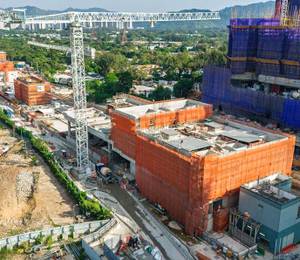AECOM has been appointed by the Land Transport Authority (LTA) of Singapore as the lead consultant to carry out an advanced engineering study (AES) for the complete design of the Singapore stretch of the Kuala Lumpur-Singapore high-speed rail (HSR) infrastructure.
Under the S$24.6 million contract, AECOM and its consortium partners will provide architectural, civil, structural, electrical, mechanical and other associated design services needed for the Jurong East terminus, tunnels and the bridge connecting Singapore and Malaysia at the Straits of Johor.
“The Kuala Lumpur-Singapore high-speed rail is a key project for the governments of Singapore and Malaysia and will be an iconic landmark, providing the strategic link between both cities,” said Billy Wong, AECOM’s regional executive of Southeast Asia. “AECOM is delighted to apply our global high-speed rail capability in the design of this groundbreaking high-speed rail infrastructure project, which is the first inter-country high speed rail service in Southeast Asia.”
AECOM said it has assembled a global team of high-speed rail specialists from Singapore, Hong Kong and Spain to deliver the project. The team will draw upon the design and planning expertise gained from working on the West Kowloon Terminus for the Express Rail Link in Hong Kong, Hong Kong-Zhuhai-Macao Cross Boundary Facilities and the HSR infrastructure in Spain.
AECOM Singapore has also worked with LTA to design the North East Line, Circle Line, Downtown Line and Thomson-East Coast Line, and the Tuas West Extension. In addition, the Singapore team is already conducting an engineering consultancy study for the Rapid Transit System Link between Singapore and Johor Bahru, Malaysia.
In undertaking the AES, AECOM and its consortium partners – HSR architect Farrells and local architects Architects 61 and CPG Consultants – have commenced work on the HSR concept design and will facilitate on-schedule implementation through the provision of ‘buildable’ design.
“The Jurong East terminus design will be a key international gateway to travellers and should be a true reflection of Singapore, meeting its high standards for functionality, safety, efficiency and accessibility,” said Mahatma Subbaiyan, vice president of transportation, AECOM Singapore. “With our experience and technical knowledge in HSR design, we will ensure that the project attracts the best international and local bidders as we transit from design to build phase.”
At present, the Singapore-KL route is served by planes and buses. Once completed in 2026, its tracks will run for 350 km along the west coast of Peninsula Malaysia – with 15 km in Singapore and 335 km in Malaysia – and is expected to cut travel time between both cities to 90 minutes.











